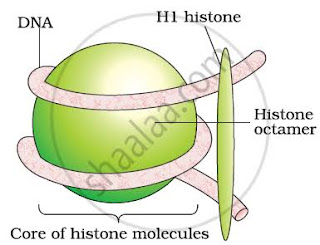CELL ORGANELLES - NUCLEUS
NUCLEUS
- first described by Robert Brown.
- Nucleus was named chromatin by Flemming.
- The interphase ( non dividing cell phase) nucleus has highly extended and elaborate nucleoprotein fibres called chromatin, nuclear matrix and one or more spherical bodies called nucleoli.
- The nuclear envelope consists of two parallel membranes with a space between them called the perinuclear space.
- At a number of places, the nuclear envelope is interrupted by minute pores, which are formed by the fusion of its two membranes.
- nuclear matrix --nucleoplasm
- The nucleoli are spherical structures present in the nucleoplasm.
- Nucleolus is the site of active ribosomal RNA (rRNA) synthesis.
- A loose and indistinct network of nucleoprotein fibres is called chromatin.
- During different stages of cell division, cells show structured chromosomes in place of the nucleus.
- Chromatin contains DNA and some basic proteins called histones, some non-histone proteins and also RNA.
- Every chromosome -- a primary constriction or the centromere on the sides of which disc shaped structures called kinetochore are present.
- Based on the position of the centromere, the chromosomes can be classified into four types
- Metacentric
- Submetacentric
- Acrocentric
- Telocentric
- The metacentric chromosome has middle centromere -- two equal arms of the chromosome.
- The sub-metacentric chromosome has centromere nearer to one end of the chromosome -- one shorter arm and one longer arm.
- In case of acrocentric chromosome, the centromere is situated close to its end -- one extremely short and one very long arm
- telocentric chromosome -- terminal centromere.
- Sometimes a few chromosomes have non-staining secondary constrictions, which gives the appearance of a small fragment called the satellite - SAT CHROMOSOME.
MICROBODIES
- Many membrane bound minute vesicles are called microbodies.
- Microbodies contain various enzymes, are present in both plant and animal cells.







No comments:
Post a Comment